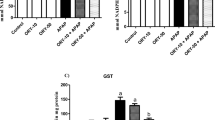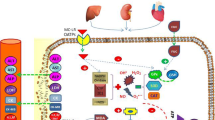Abstract
Oxidative stress (OS) plays an important role in the progression of chronic liver disease including organ injury and hypoalbuminemia. Long-term oral supplementation with branched-chain amino acids (BCAAs) can inhibit liver dysfunction but their role in the prevention of liver fibrosis and injury to the liver is unclear. The aim of this study was to assess how BCAAs preserve liver function from OS. To investigate how BCAAs specifically prevent OS, we evaluated the effect of oral supplementation with BCAAs on OS using a rat liver cirrhosis model. Liver cirrhosis was induced in ten male Sprague–Dawley rats by administering carbon tetrachloride for 12 weeks. Five of the ten carbon tetrachloride-treated rats were assigned to a control group and five to a BCAA group. BCAA-supplementation significantly preserved plasma albumin concentrations and significantly inhibited the occurrence of organ injury as determined by blood chemistry analysis. Hepatic expression of OGG1 mRNA was increased in the BCAA group compared to the control group. In the BCAA group, increased hepatic levels of OGG1 protein were found by western blot. On the other hand, the number of 8-OHdG-positive cells was significantly higher in liver sections taken 1 month after carbon tetrachloride treatment. Furthermore, OGG1-positive cells were significantly increased in the hepatocytes around the central vein. BCAA was found to reduce OS, which could possibly lead to a decrease in the occurrence of hypoalbuminemia and organ injury. Our results indicate that BCAA-enriched nutrients stimulate antioxidant DNA repair in a rat model of liver injury induced by carbon tetrachloride.




Similar content being viewed by others
References
Jain SK, Pemberton PW, Smith A, McMahon RF, Burrows PC, Aboutwerat A et al (2002) Oxidative stress in chronic hepatitis C: not just a feature of late stage disease. J Hepatol 36:805–811
Jüngst C, Cheng B, Gehrke R, Schmitz V, Nischalke HD, Ramakers J et al (2004) Oxidative damage is increased in human liver tissue adjacent to hepatocellular carcinoma. Hepatology 39:1663–1672
Nishikawa T, Nakajima T, Katagishi T, Okada Y, Jo M, Kagawa K et al (2009) Oxidative stress may enhance the malignant potential of human hepatocellular carcinoma by telomerase activation. Liver Int 29:846–856
Caldwell SH, Chang CY, Nakamoto RK, Krugner-Higby L (2004) Mitochondria in nonalcoholic fatty liver disease. Clin Liver Dis 8:595–617
Begriche K, Igoudjil A, Pessayre D, Fromenty B (2006) Mitochondrial dysfunction in NASH: causes, consequences and possible means to prevent it. Mitochondrion 6:1–28
Kaneko T (2003) Aging and the accumulation of oxidative damage to DNA. J Clin Biochem Nutr 34:51–60
Fujimoto Y, Morinaga K, Abe M, Kitamura T, Sakuma S (2009) Selenite induces oxidative DNA damage in primary rat hepatocyte cultures. Toxicol Lett 191:341–346
Powell CL, Swenberg JA, Rusyn I (2005) Expression of base excision DNA repair genes as a biomarker of oxidative DNA damage. Cancer Lett 229:1–11
Okabayashi T, Nishimori I, Sugimoto T, Iwasaki S, Akisawa N, Maeda H et al (2008) The benefit of the supplementation of perioperative branched-chain amino acids in patients with surgical management for hepatocellular carcinoma: a preliminary study. Dig Dis Sci 53:204–209
Okabayashi T, Nishimori I, Sugimoto T, Maeda H, Dabanaka K, Onishi S et al (2008) Effects of branched-chain amino acids-enriched nutrient support for patients undergoing liver resection for hepatocellular carcinoma. J Gastroenterol Hepatol 23:1869–1873
Okabayashi T, Iyoki M, Sugimoto T, Kobayashi M, Hanazaki K (2011) Oral supplementation with carbohydrate- and branched-chain amino acid-enriched nutrients improves postoperative quality of life in patients undergoing hepatic resection. Amino Acids 40:1213–1220
Kajiwara K, Okuno M, Kobayashi T, Honma N, Maki T, Kato M et al (1998) Oral supplementation with branched-chain amino acids improves survival rate of rats with carbon tetrachloride-induced liver cirrhosis. Dig Dis Sci 43:1572–1579
Standish RA, Cholongitas E, Dhillon A, Burroughs AK, Dhillon AP (2006) An appraisal of the histopathological assessment of liver fibrosis. Gut 55:569–578
Yang J, Ikezoe T, Nishioka C, Takezaki Y, Hanazaki K, Taguchi T et al (2012) Long-term exposure of gastrointestinal stromal tumor cells to sunitinib induces epigenetic silencing of the PTEN gene. Int J Cancer 130:959–966
Marchesini G, Marzocchi R, Noia M, Bianchi G (2005) Branched-chain amino acid supplementation in patients with liver diseases. J Nutr 135:1596S–1601S
Nishimura T, Yoshida Y, Watanabe F, Koseki M, Nishida T, Tagawa K et al (1986) Blood level of mitochondrial aspartate aminotransferase as an indicator of the extent of ischemic necrosis of the rat liver. Hepatology 6:701–707
Fujimoto Y, Morinaga K, Abe M, Kitamura T, Sakuma S (2009) Selenite induces oxidative DNA damage in primary rat hepatocyte cultures. Toxicol Lett 191:341–346
Pal S, Polyak SJ, Bano N, Qiu WC, Carithers RL, Shuhart M et al (2010) Hepatitis C virus induces oxidative stress, DNA damage and modulates the DNA repair enzyme NEIL1. J Gastroenterol Hepatol 25:627–634
Kamiyama H (2003) Mutagenic potentials of damaged nucleic acids produced by reactive oxygen/nitrogen species: approaches using synthetic oligonucleotides and nucleotides. Nucleic Acids Res 31:517–531
Powell CL, Swenberg JA, Rusyn I (2005) Expression of base excision DNA repair genes as a biomarker of oxidative DNA damage. Cancer Lett 229:1–11
Kang KA, Lee JH, Chae S, Zhang R, Piao MJ, Kim HS et al (2009) Butin decreases oxidative stress-induced 8-hydroxy-2′-deoxyguanosine levels via activation of oxoguanine glycosylase 1. Chem Biol Interact 30(181):338–342
Chaveroux C, Lambert-Langlais S, Parry L, Carraro V, Jousse C, Maurin AC et al (2011) Identification of GCN2 as new redox regulator for oxidative stress prevention in vivo. Biochem Biophys Res Commun 415:120–124
Wu WT, Lin NT, Subeq YM, Lee RP, Chen IH, Hsu BG (2010) Erythropoietin protects severe haemorrhagic shock-induced organ damage in conscious rats. Injury 41:724–730
Sträter J, Möller P (1998) Pathogenesis of primary biliary cirrhosis: CD95-induced apoptosis at last? Eur J Gastroenterol Hepatol 10:539–541
Fox ES, Kim JC, Tracy TF (1997) NF-kappaB activation and modulation in hepatic macrophages during cholestatic injury. J Surg Res 72:129–134
Dunger A, Cunningham JM, Delaney CA, Lowe JE, Green MH, Bone AJ et al (1996) Tumor necrosis factor-alpha and interferon-gamma inhibit insulin secretion and cause DNA damage in unweaned-rat islets. Extent of nitric oxide involvement. Diabetes 45:183–189
Sasaki A, Kamiyama T, Yokoo H, Nakanishi K, Kubota K, Haga H et al (2010) Cytoplasmic expression of CD133 is an important risk factor for overall survival in hepatocellular carcinoma. Oncol Rep 24:537–546
Kohga K, Tatsumi T, Takehara T, Tsunematsu H, Shimizu S, Yamamoto M et al (2010) Expression of CD133 confers malignant potential by regulating metalloproteinases in human hepatocellular carcinoma. J Hepatol 52:872–879
Acknowledgments
The Kochi University Discretionary Fund.
Author information
Authors and Affiliations
Corresponding author
Rights and permissions
About this article
Cite this article
Ichikawa, K., Okabayashi, T., Shima, Y. et al. Branched-chain amino acid-enriched nutrients stimulate antioxidant DNA repair in a rat model of liver injury induced by carbon tetrachloride. Mol Biol Rep 39, 10803–10810 (2012). https://doi.org/10.1007/s11033-012-1974-4
Received:
Accepted:
Published:
Issue Date:
DOI: https://doi.org/10.1007/s11033-012-1974-4




